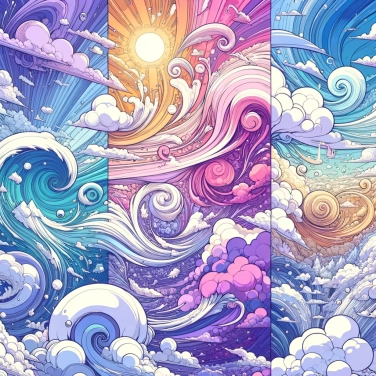The sky may appear violet at sunset due to the scattering of light by air molecules, which disperse the colors of the visible spectrum. Blue is more scattered than other colors, leaving violet more visible at the horizon.

Sunlight generally appears white to us, but it is actually made up of many different colors. Each color corresponds to a specific wavelength. When sunlight passes through the Earth's atmosphere, the colors scatter differently: short wavelengths (blue and violet) are more easily deflected than longer wavelengths like yellow or red. During the day, our eyes easily capture blue, hence the usual color of the sky. However, at sunset, the light travels longer through the atmosphere, which further increases this scattering. At that precise moment, the sky can turn shades of red or orange, but sometimes certain very specific atmospheric conditions amplify the scattering of violet. The result: you find yourself with a stunning sky in purple hues that are truly extraordinary.
The atmosphere is composed of different gases such as nitrogen, oxygen, and water vapor. Their presence in varying amounts can alter the colors perceived by our eyes during sunsets. For example, air rich in humidity can make the sky appear more purple. Humidity creates a particular diffusion of light rays, enhancing certain colors like violet and indigo. The same goes for ozone at high altitudes: depending on its concentration, the purple hue in the sky can slightly intensify. This is why certain regions, depending on their climate or the prevailing air currents, more frequently observe these purple shades in the evening.
When a lot of pollution or particles float in the air (smoke, dust, pollen), they interact with sunlight. They filter certain light rays and allow more cool colors, such as violet or deep blue, to pass through. When the sun descends toward the horizon, its rays pass through a thick layer of air filled with these tiny impurities. As a result, the sky takes on stunning shades, sometimes even moving towards unusual violet tones visible to the naked eye. This colorful spectacle is further heightened during periods of wildfires or when urban pollution reaches high levels.
When the sun is low, its rays pass through a longer layer of atmosphere before reaching our eyes. This longer distance accentuates the effect of light scattering: the shorter colors like blue are scattered first, followed by green and yellow. In the end, mainly red-pink or sometimes even slightly violet hues remain. A very low angle of incidence can intensify this phenomenon and produce those astonishing purple-violet shades that are sometimes seen on the horizon. It all depends on the path taken by the solar rays through the atmosphere: the longer they pass through, the more the visible colors shift towards red, pink, and then violet.
In 1883, after the eruption of the Krakatoa volcano in Indonesia, the purple hues during sunsets were particularly noted around the world, provoking questions and wonder among observers of the time.
The hues of the sky at twilight can also be influenced by urban light pollution. Artificial lighting alters the perception of the color palette, sometimes slightly transforming the natural tones observed.
The phenomenon of the purple sky is often amplified following a significant volcanic eruption. Indeed, the dispersion of small sulfur particles emitted into the upper atmosphere creates vivid and unusual colors during sunsets for several weeks, or even months.
On Mars, sunsets have inverted colors compared to Earth: the sky appears blue during Martian twilight, while it is reddish during the day due to different suspended particles.
Dispersion is the phenomenon by which white light, composed of several colors, separates when it passes through an atmospheric medium with a different refractive index. Diffusion, on the other hand, is the interaction of light rays with atmospheric particles, changing their direction and intensity without necessarily separating the colors.
During the day, sunlight passes through a thinner atmosphere, and the angle of the sun is different, which mainly promotes the scattering of shorter wavelengths (blue). As a result, violet hues are less visible or blend in with the ambient blue of the sky.
During these times, the sun is low on the horizon, and the light passes through a thicker layer of the atmosphere. This promotes the scattering of certain wavelengths of light, such as red, orange, and sometimes even violet, giving the sky these particular colors.
Yes, fine particles and pollution present in the atmosphere can enhance colors, particularly bright shades like orange, red, or violet. These particles promote an increased scattering of light rays, resulting in more intense-colored sunsets.
Yes, indeed! Even without pollution, certain specific atmospheric conditions such as a high humidity level, the presence of thin clouds, or the precise angle of the sun at dusk are enough to create a particular dispersion that makes purple hues appear in the sky.

No one has answered this quiz yet, be the first!' :-)
Question 1/5